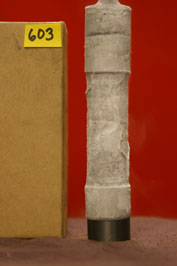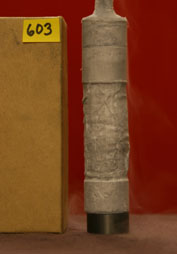Legend: Upper graph of each pair is motor speed V (proportional to edot); lower graph is load (in volts). Translate motor V to edot thus: V0.1≈7e-7/s. Load to stress translation is 0.245 MPa/mV, with a ~6 mV zero offset. Horizontal scale is time. 5000≈14 hrs. |
|
.png) |
e=0.127 |
1626 hrs 6/10, entirety of step (3) , end of run. Crunching the numbers real fast says the high T sensitivity continues. That bump in stress about 3/4 through the step was an inadvertent -0.5 K T drop. Sample and machine effects are both included in the bump. Out comes the sample... |
.png) |
e=0.085 |
2109 hrs 6/9, entirety of step (2). This is surely close enough to steady state for present purposes. Note the exceedingly fine stress scale, roughly a 0.25-MPa range. There is a small upward trend of the lower chart because it actually charts load rather than stress. As the sample gets shorter and fatter, automatic recalculation of load keeps stress constant.
Unload and leave overnight; warm to 195 K and deform tomorrow. |
.png) |
e=0.041 |
1238 hrs 6/9, beginning of step (2). Now operating in creep mode. Stress is 5.2 MPa and resultant edot≈1.4e-6/s. We can't say yet whether or not this is steady state of course, but at this same stress and temperature, pure ice in the steady state is 2 orders of magnitude more viscous that what we see here.
Creep in the perchlorate hydrate appears to be hugely more T sensitive than in pure ice |
.png) |
e=0.033 |
Same as below, finer stress scale. The run condition ended up being constant displacement rate (top chart). Look for more operation in creep mode (constant stress) in later steps.
Now sitting unloaded, waiting for T to warm to 190 K. |
.png) |
e=0.033 |
0621 hrs 6/9, to end of step (1), coarse scale. A sort of steady state was finally reached after maybe 2% strain, which jibes with what it might have taken to square the bottom platen of the sample. Stress peaked at about 19 MPa--making it about 10x less viscous than pure ice in dislocation creep--then dropped back 1 MPa or so. For a survey run, this is sufficient. We can go back and investigate these details of deformation physics later. |
.png) |
e=0.008 |
Same as below, with lower chart on a much finer scale, about 1.2 MPa range. I'm search here for a stress level that will maintain a strain rate near 1e-7, in order to put enough strain into this thing overnight. The sample is strain hardening here for at least two non-intrinsic reasons, residual porosity and a not quite square bottom end (see photo above). We need to put a few percent strain into this thing to get past this.
But for now, pure ice toodling along in steady state at this strain rate at this temperature requires about 40 MPa differential stress. Here, it's about 12 MPa and rising. Standby. |
.png) |
e=0.008 |
1848 hrs 6/8/10. Very coarse scale on the lower chart (stress), from roughly 0 to 12 MPa differential stress. 0.10 on the upper chart is about 0.7e-6/s. |


.png)
.png)
.png)
.png)
.png)
.png)
.png)